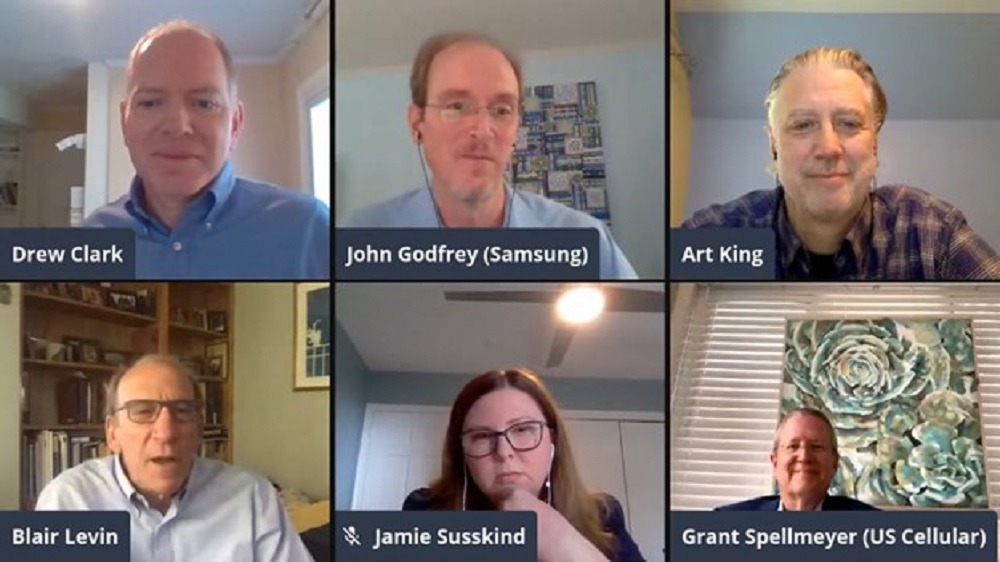Broadband Breakfast Live Online on Wednesday, October 14, 2020 — The Hype and Reality of 5G
See “‘A No-Nonsense Guide to 5G’ Kicks Off With Discussion About Spectrum, Rights of Way and Wall Street,” Broadband Breakfast, November 2, 2020 Our newest series is “A No-Nonsense Guide to 5G,” which will explore the policy, technology and practical questions about 5G. They include what’s real and

Our newest series is “A No-Nonsense Guide to 5G,” which will explore the policy, technology and practical questions about 5G. They include what’s real and what’s hype, trusted partners, transformative apps in the enterprise, wireless infrastructure facilities, and continued modernization of the nation’s spectrum policies.

This opening panel will set the stage for Broadband Breakfast Live Online’s consideration of the policy, technology and practical questions around the 5G wireless standard. What is 5G, and why is there so much buzz about it? How much of an improvement is it over prior generations of wireless? In other words: What is real, and what is hype? How the issues of trusted partners, rights-of-way deployment, and spectrum policy interact? Where is 5G seeing early successes, and what are the stumbling blocks?”
WATCH HERE, or on YouTube, Twitter and Facebook.
This event is part of a six-part event series, “A No-Nonsense Guide to 5G,” on Broadband Breakfast Live Online.
Panelists include:
- Blair Levin, former Executive Director of the National Broadband Plan
- John Godfrey, Senior Vice President of Public Policy for Samsung Electronics America
- Art King, Director of Enterprise Services, Corning Optical Communication
- Grant Spellmeyer, Vice President, Federal Affairs and Public Policy, US Cellular
- Jamie Susskind, Vice President of Policy and Regulatory Affairs for the Consumer Technology Association
- Drew Clark (Moderator), Editor and Publisher, Broadband Breakfast

Blair Levin, John Godfrey, Art King, Grant Spellmeyer, Jamie Susskind, Drew Clark
Blair Levin is a nonresident senior fellow with the Metropolitan Policy Program at Brookings. He serves as the executive director of Gig.U: The Next Generation Network Innovation Project, an initiative of three dozen leading research university communities seeking to support educational and economic development by accelerating the deployment of next generation networks. Previously, he worked with the Communications & Society Program with the Aspen Institute Communications and Society Program, following his departure in 2010 from the Federal Communications Commission where he oversaw the development of a National Broadband Plan.
John Godfrey is Senior Vice President of Public Policy for Samsung Electronics America and leads Samsung’s focus on communications policy, digital television, wireless spectrum, health care, environment, broadband, cybersecurity and privacy. Prior to joining Samsung, Godfrey served as vice president of government affairs for Pioneer North America and previously as director of government affairs for Sony Electronics. Godfrey has worked with the Information Technology Industry Council, the National Research Council, SRI International, and was previously chairman of the Consumer Technology Association Foundation’s Board of Trustees and on the Board of Directors of the Advanced Television Systems Committee.
Art King leads the development of enterprise services definitions and business case propositions for customers and partners for Corning Optical Communications. He came to Corning via the SpiderCloud Wireless acquisition and was formerly a lead in information technology architecture and operations for Nike Inc. He also led the build-out for an internet protocol services network vendor and managed regional infrastructure operations at an electric utility.
Grant Spellmeyer is Vice President of Federal Affairs and Public Policy for US Cellular where he leads all federal and state legislative and regulatory affairs for the wireless provider. Prior to joining US Cellular 14 years ago, he worked for TDS Telecom and was an attorney in private practice.
Jamie Susskind is Vice President of Policy and Regulatory Affairs for the Consumer Technology Association. She coordinates CTA’s advocacy strategy and represents the association before federal agencies and the administration for policies to encourage the growth of innovative consumer technologies. Susskind oversees a portfolio of policy issues, including cybersecurity, the Internet of Things, content moderation, equipment authorizations and standard setting, consumer protection, spectrum, and broadband and infrastructure deployment.
Panelist resources
Recent Broadband Breakfast Articles in the 5G Category
“A No-Nonsense Guide to 5G” is sponsored by:

Events in “A No-Nonsense Guide to 5G” include:
- Wednesday, October 14, 2020, 12 Noon ET — “A No-Nonsense Guide to 5G: The Hype and the Reality of 5G”
- This opening panel will set the stage for Broadband Breakfast Live Online’s consideration of the policy, technology and practical questions around the 5G wireless standard. What is 5G, and why is there so much buzz about it? How much of an improvement is it over prior generations of wireless? In other words: What is real, and what is hype? How the issues of trusted partners, rights-of-way deployment, and spectrum policy interact? Where is 5G seeing early successes, and what are the stumbling blocks?”
- Wednesday, October 28, 2020, 12 Noon ET — “A No-Nonsense Guide to 5G: National Security and Trusted Partners”
- This panel will consider the global landscape for the 5G equipment ecosystem. It will consider issues in core networks, radio access networks and in handset equipment. How has the global landscape changed? Will 5G benefit from – or suffer because of – a new Cold War with China? How are American companies reacting to federal government initiatives for trusted partners? Where can the U.S. turn for solutions and alternatives to Chinese manufacturers?
- Wednesday, November 18, 2020, 12 Noon ET — “A No-Nonsense Guide to 5G: A Case Study of Transformative Apps in the Enterprise”
- 5G is seeing its first real successes in the enterprise marketplace. To glimpse the future more accurately, Broadband Breakfast Live Online will consider case studies of applications in enterprise environments. What technologies and processes bring 5G success to the business marketplace? What needs to happen to bring 5G successes to the consumer marketplace?
- Wednesday, December 9, 2020, 12 Noon ET — “A No-Nonsense Guide to 5G: Wireless Infrastructure, Municipal Rights-of-Way and the 5G Rural Fund”
- To realize the promise of 5G, far more base stations — wireless infrastructure facilities — will be necessary. 5G facilities and towers may not be as big as in previous generations of wireless technology. Still, the need for far more facilities has already created tensions with municipalities over rights-of-way. How can these conflicts be minimized? What are smart cities already doing to expedite wireless infrastructure deployment? Can the process be improved?
- Wednesday, January 27, 2021, 12 Noon ET — “A No-Nonsense Guide to 5G: The Adoption and Use of 5G Broadband”
- What are some of the likely drivers of 5G equipment and services? How have existing consumer use cases been received? Are there 5G use cases that could help close the digital divide by elevating broadband utilization among communities of color and low-income populations? What can we expect from 5G technology in 2021?
- Wednesday, February 10, 2021, 12 Noon ET — “A No-Nonsense Guide to 5G: Spectrum Policies to Advance Better Broadband”
- More than simply the next generation of wireless technology, 5G deployments make use of radio frequencies from an extremely wide range. For example, some 5G deployment are using mid-band spectrum between 3.4 GigaHertz (GHz) and 6 GHz. But 5G networks also promise tap into spectrum between 24 GHz and 100 GHz. It deploys these millimeter bands using network slicing and other advanced wireless tools. What new spectrum policies are necessary for 5G to flourish?
As with all Broadband Breakfast Live Online events, the FREE webcasts will take place at 12 Noon ET on Wednesday.
SUBSCRIBE to the Broadband Breakfast YouTube channel. That way, you will be notified when events go live. Watch on YouTube, Twitter and Facebook.
See a complete list of upcoming and past Broadband Breakfast Live Online events.









